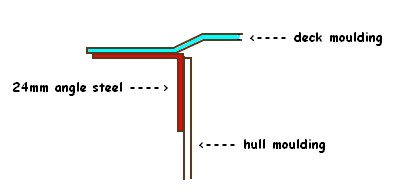3) Decisions
When I started to look at the boat I had bought I realised that although he was sound enough to be sailed as he was for the time being, he would need fairly major work in the near future. This became more obvious when I started to remove the nasty black rubber fendering around the gunwale. This was clearly an old boat (for GRP), and was constructed in an unusual fashion. Instead of the deck being bolted and glassed to a flange around the top of the hull as normally found in GRP boats, a piece of stainless steel angle had been bolted around the top of the hull to make a flange. My guess is that the hull moulding was originally designed to be finished with a wood gunwale and thwarts, but that it had been adapted to take a GRP deck with thwart and mast step moulded in. This would require less upkeep, always desirable in a hire boat. The horizontal part of the angle steel had been sawn through every eight inches so that the metal could be bent round the top of the hull moulding to form the flange - otherwise the metal simply would not bend. Here’s a sketch cross section of the hull/deck join:

Although this was odd construction it has meant that the hull has withstood the battering of the years pretty well. Although the hull moulding has been split and repaired a couple of times in the past (between waterline and gunwale, I’m glad to say) the hull has never lost shape due to any of these impacts, as the steel band is really strong. I have seen a dinghy similar to Lugg squashed between a forty foot hire cruiser and the wooden quay heading; the hull became about a foot narrower before the pressure was released, and although it more or less sprang back into shape, I would not have been happy if it had been my dinghy.
Anyway, Lugg was strong except in the deck. This had broken up around the rowlock sockets and been repaired several times, and as you can see from the photos the very front of the deck moulding simply wasn’t there any more. I decided to remove the deck, discard it, and replace it with a wooden one. This would look better - varnished wood instead of swimming-pool-blue GRP - and would enable me to alter the deck layout and attach fittings more easily. So I went for laminated wood gunwales and framing with a marine ply deck.
I went to our local specialist hardwood Timber Yard and nearly bought a plank of Mahogany 150 x 25mm x 4 metres long for the laminated parts; the bloke at the desk said it would cost me “about thirty quid” but when he came to measure it the price (with VAT) went up to fifty pounds. As one object of the exercise is to get afloat in a decent looking boat as cheaply as possible I decided to go with soft wood instead. From experience of my other wooden boats I knew that provided you choose the straightest and closest grained, most knot-free softwood and build and coat with modern epoxies durability is not a problem; and such woods can be stained to resemble mahogany or whatever. And they’re more environmentally friendly. So I spent seventeen pounds (and a lot of time selecting my pieces) on softwood and started to saw up 10mm wide strips for laminating.
Meanwhile the original deck was retained to provide measurements for positioning of rowlocks, mast step and seat.
With the acquisition of a dozen and a half clamps and the spending of another seventeen pounds on SP Systems 106 Epoxy, I was ready to begin.
|

